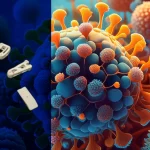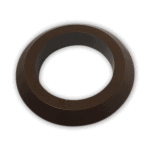An Informational Brief on Polymer Machining
One of the high-performance polymers we precision machine is ECTFE (Ethylene Chlorotrifluoroethylene). It is marketed under the branded name of Halar® ECTFE by Solvay Specialty Polymers. This material was developed to provide chemical resistance in heavy duty corrosion applications, such as acid handling, mining applications and class 8 hazardous goods transportation.
AIP has over 37 years of experience machining complex components from thermoplastics like Ethylene Chlorotrifluoroethylene. In this insightful technical brief, we will discuss what goes into machining ECTFE and how it differs from other manufacturing options such as metal machining, injection molding, and 3D printing.
Properties of ECTFE
It is beneficial to keep information on the properties of a thermoplastic pre-machining. This helps in selecting the right thermoplastic for a project. Furthermore, it assists in evaluating if the material is a candidate for the end-use requirement. Below are some of the key characteristics of Ethylene Chlorotrifluoroethylene:
Key features of ECTFE
- Chemical Resistance
- Corrosion Resistance
- High Resistivity
- High Strength
- Low Dielectric Constant
ECTFE (Ethylene Chlorotrifluoroethylene) is a fluorocarbon-based polymer manufactured from Halar® resin. It is an extremely pure polymer. Static soak testing in ultra-pure water and high purity chemicals shows low levels of metallic and organic extractables.
Offering high strength, high resistivity, a low dielectric constant and good chemical and corrosion resistance from -105°F (-76°C) to 300°F (150°C), ECTFE is very similar to Teflon (PTFE), the major difference between them being that ECTFE has a slightly lower melting point.
| Material Property | Units | Value |
| Tensile Elongation at Break @73 F | % | 250 |
| Flexural Modulus of Elasticity @ 73 F | psi | 245000 |
| Tensile Modulus of Elasticity @ 73 F | psi | 240000 |
| Flexural Strength @ 73 F | psi | 6800 |
| Hardness Shore D | – | D75 |
| Tensile Strength @73 F, (ult)/(yld) | psi | 4300(yld) |
| Notched Izod Impact @73 F | ft-lb/in of notch | No Break |
| Heat Deflection Temperature @ 264 psi | F | 145(yld) |
| Melting Point, (VS = Vicat Softening Temp) | F | 437 |
| Coefficient of Linear Thermal Expansion @73 F | in/in/F | 5.6E-05 |
| Dielectric Strength, Short Term | Volts/mil | 350 |
| Water Absorption 24 hours | % by weight | 0.1 |
Applications of ECTFE
ECTFE is widely used in anti-corrosion applications across a wide range of markets. This includes coatings for self-supporting constructions (pipes) and architectural films. Due to its excellent fire-resistance and chemical resistance, it is a prime product for wire and cable, communication cable and specialty cable applications. As a fluoropolymer with good UV resistance, it is often used for outdoor applications. ECTFE films can be transparent and provide UV protection for underlying layers.
It comes in several forms, such as monofilament fibers in the chemical process industry, powders over metal, films, sheets and various molded precision parts.
Other common applications include:
- Chemical Storage
- Containers
- Fire Safe Componentry
- Fluid Handling
- Housing Parts
- Housings
- Pipes
- Pump Parts
- Seals
- Semiconductor Process Equipment
- Sleeves
Grades of ECTFE
At AIP, we machine various grades and brand name Ethylene Chlorotrifluoroethylene (ECTFE), including the following:
- HALAR®
- HALAR® RESIN
- SUSTA ECTFE
- SYMALIT ECTFE
Our close ties with the industry’s leading plastics manufacturers give us even further insight and access to technical help in material selection, sizing and manufacturing procedures. Whatever your application, our machinists can help you in material selection, sizing and manufacturing techniques from concept to completion.
Machining ECTFE
Annealing ECTFE
Annealing and stress-relieving plastics is critical to the machining process. Cracking and crazing can happen if ECTFE is not machined with coolants, lubricants and trained procedures. Due to the low thermal conductivity of Halar® ECTFE, slow heating and cooling is required for this step. The annealing process at AIP greatly reduces the chances of these stresses occurring from the heat generated during machining polymers like ECTFE. Our machinists use computer controlled annealing ovens for the highest quality precision temperatures and time control.
Machining ECTFE
Machining ECTFE is similar to machining Nylon Polyamide. As a general rule of thumb, use sharp tools, avoid excessive clamping and cutting forces and use coolants to prevent overheating. With a relatively low melting point at 242 C (468 F), ECTFE may soften quickly. We recommend non-aromatic, water-soluble coolants because they are most suitable for ideal surface finishes and close tolerances. These include pressurized air and spray mists. Coolants have the additional benefit of extending tool life as well.
Some companies machine both metals and plastics, which has detrimental outcomes for machined polymer products. Many past experiences have shown parts going to customer without cracks, only to develop surface cracks and warping over time due to exposure to metal machine shop fluids. Be sure to use a facility like AIP that only machines polymers.
Preventing Contamination
Contamination is a serious concern when machining polymer components for technically demanding industries such as aerospace and medical sciences. To ensure the highest level of sanitation down to the sub-molecular level, AIP Precision Machining designs, heat-treats, and machines only plastics with any sub-manufactured metalwork processed outside our facility. This allows us to de-risk the process from metallic cross contamination.
Ethylene Chlorotrifluoroethylene Machining Guide: Supportive Information
Chemical Resistant Materials
Quality Assurance Certifications
Looking for corrosion and chemical resistant materials like ECTFE for your precision machined part?






